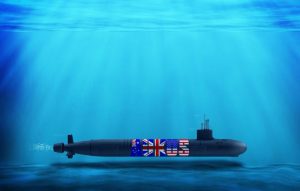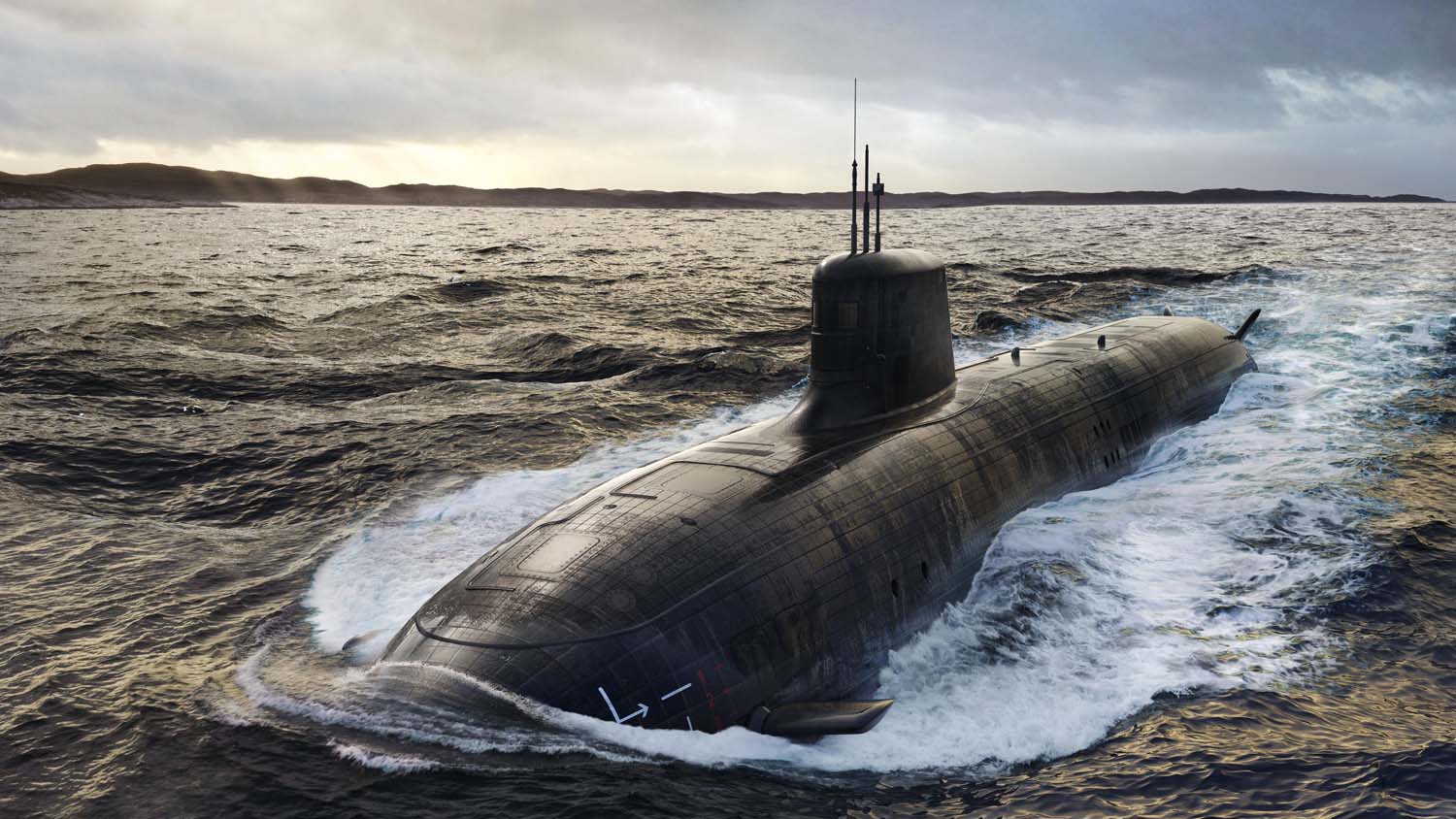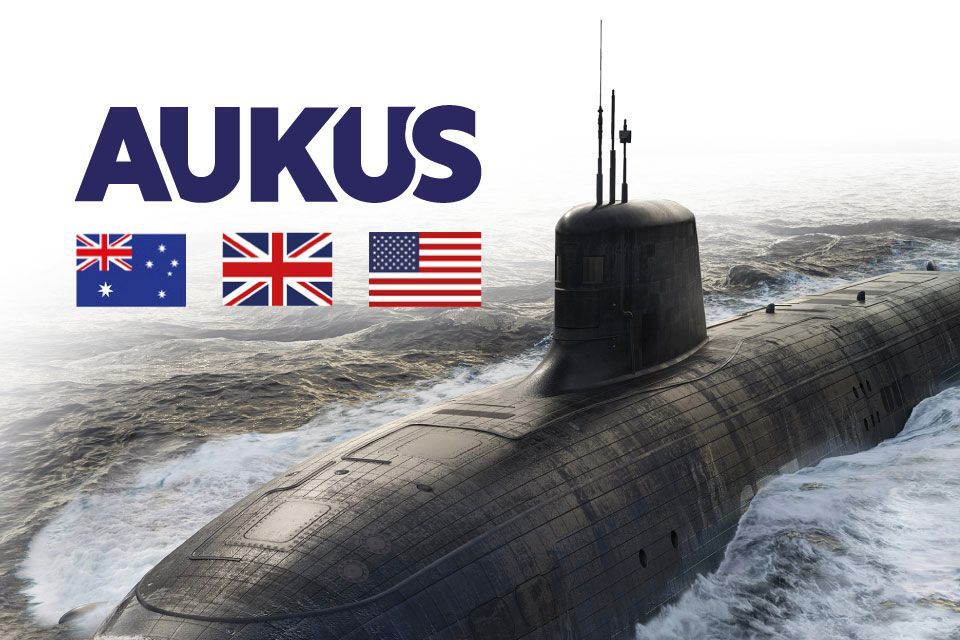Dr Joseph Camilleri | 25 June 2023

The AUKUS agreement reached in September 2021 has left Australia more deeply entangled with US strategic priorities and war preparations than ever before.
AUKUS reflects the prevalent view within the US security establishment that China’s rise poses a major threat to America’s regional and global dominance – a view, as it happens, strongly supported by Australia’s security elite.
Australian governments, under the previous conservative coalition and now under Labor, have repeatedly pointed to China’s misdeeds. In a major address in April, Foreign Minister Penny Wong took issue with China’s rapidly rising defence budget, its militarisation of disputed islands in the South China Sea, its ballistic missiles falling in Japan’s exclusive economic zone, and its military drills and blockades around Taiwan.
By contrast, Australia has steadfastly refrained from criticising the United States for any of its provocative actions, not least Nancy Pelosi’s much publicised visit to Taiwan or Biden’s often stated position that US forces would intervene should Taiwan come under threat.
Meanwhile, Australian mainstream media have dutifully reported US and Australian portrayals of the China threat, and become increasingly vociferous contributors to the anti-China frenzy.
The rhetoric has been faithfully supported by action. The last few years have seen the steady expansion of joint US-Australian military exercises, notably Talisman Sabre and Exercise Pacific Vanguard.
In addition, the United States now controls or has extensive access to an ever larger array of military assets on Australian soil, including the high-technology bases cluster along the length of North West Cape in Western Australia, the port and air base of Darwin, and the Tindal air base.
To this must be added the large and still growing Pine Gap facility likely to play a key role in any US conventional and nuclear operations from Africa to the Pacific.
Simply put, once China’s rise came to be seen by the US security establishment as inimical to its interests, Australian governments have been quick to follow suit.
Unsurprisingly, the Australian government secured the services of two retired US admirals and three former US Navy officials as highly paid consultants to advise it during the negotiations to acquire top-secret nuclear submarine technology. This advice no doubt contributed to the cancellation of the French submarine contract and the establishment of AUKUS.
All of which prompts the question: what lies behind Australia’s subservience to US militarism? Much of it has to do with the fact that Australia’s policy makers have traditionally felt most comfortable when connected to the Anglophone world and at best uneasy when dealing with the East.
One other pull factor helps explain the addiction to imperial power. Australia’s political, bureaucratic, military and intelligence elites see themselves as having unique access to an exclusive and powerful club that confers status and privileges – once the British club, now the American club. They may have reluctantly accepted the demise of the former, but are in no mood to accept the slow but steady decline of the latter.
 The first tangible commitment under the highly secretive AUKUS arrangements is the decision to provide Australia with eight nuclear powered submarines (SSNs) at an estimated cost of $368 billion. The plan, however, is fraught with uncertainty and danger. Will the submarines be delivered on time? Will the cost involved greatly exceed the current estimate?
The first tangible commitment under the highly secretive AUKUS arrangements is the decision to provide Australia with eight nuclear powered submarines (SSNs) at an estimated cost of $368 billion. The plan, however, is fraught with uncertainty and danger. Will the submarines be delivered on time? Will the cost involved greatly exceed the current estimate?
Added to this are the complex technological and security problems that will inevitably arise.
First, to build nuclear powered submarines, Australia will need to be supplied not just with the technology for the nuclear reactors, but also with the nuclear fuel. Transport of such fuels over long distances raises the prospect of diversion to a third party, widely considered a major nuclear proliferation risk.
Secondly, the nuclear reactors used by the submarines will generate a significant amount of nuclear waste, which will have to be returned to the supplying country or stored in Australia. Either way, the country will face the highly contentious problem of nuclear waste disposal.
Thirdly, there is always the possibility of a nuclear reactor being breached, or at least of a leakage of nuclear materials. The AUKUS deal poses troubling questions that remain unanswered. If answers are ever offered, they are likely to prove less than reassuring.
In short, Australia has saddled itself with a vast military project of unknown cost and duration and dubious effectiveness. It will contribute to an ever-increasing defence budget that will divert scarce resources from urgent social and economic priorities.
Importantly, it will fan the flames of resentment in China not just amongst the Chinese leadership, but amongst a wide cross-section of Chinese society. Beijing has repeatedly argued that the AUKUS project will fuel an arms race and raise the level of mutual mistrust. It will certainly reinforce China’s perception that it is surrounded by a hostile coalition.
While the reactions of other countries have been generally more subdued, there is no denying the widespread unease AUKUS has already provoked. Some governments, it is true, have accepted the security partnership, but few have done so with undiluted enthusiasm.
Singapore has indicated support in principle for AUKUS insofar as it helps to balance China’s assertiveness and contributes to regional peace and stability. The Philippines, for its part, has gone so far as to characterise AUKUS as “essential to our national development and to the security of the region”.
Japan too has generally welcomed AUKUS which it sees as “strengthening engagement [of those three countries] in the Indo-Pacific region”. There have even been indications that Japan would cooperate closely with AUKUS. Some have even contemplated the possibility that Japan might join AUKUS at some future date. It is worth noting, however, that Tokyo has studiously refrained from open support of the submarines deal because the acquisition of nuclear submarines remains a highly contentious issue in the context of both Japanese politics and public opinion.
South Korea too has been guarded in its comments, expressing support for AUKUS insofar as it contributes to regional peace and security, but has said little about the nuclear submarine program.
 The response of other ASEAN countries has ranged from unease to open criticism. Vietnam, notwithstanding its territorial dispute with China, has said little about AUKUS, confining itself to support for the peaceful use of nuclear energy. Thailand has gone further and expressed concern that AUKUS could fuel a regional arms race.
The response of other ASEAN countries has ranged from unease to open criticism. Vietnam, notwithstanding its territorial dispute with China, has said little about AUKUS, confining itself to support for the peaceful use of nuclear energy. Thailand has gone further and expressed concern that AUKUS could fuel a regional arms race.
Indonesia has been especially critical. It sees AUKUS as committed to the forward projection of military power which could well provoke China into adopting an even more assertive stance. In Indonesia’s view, Australia’s acquisition of nuclear powered submarines could “set a dangerous precedent” for other countries with similar ambitions “to follow suit”.
Malaysia too has expressed deep misgivings. While acknowledging the right of the countries concerned to upgrade their defence capabilities, it has more than once made it clear that it expects all countries, including the three AUKUS partners, to fully respect and comply with Malaysia’s requirements with regard to nuclear-powered submarines, as stated in the Law of the Sea Convention, the Southeast Asia Nuclear Weapons Free Zone, and the ASEAN Declaration on the Zone of Peace, Freedom and Neutrality (ZOPFAN).
India, for its part, has avoided public comment on the issue. While some commentators have suggested that AUKUS could help check “China’s aggression”, many others fear the prospect of an even more assertive China. A growing Chinese naval presence in the Indian Ocean cannot but pose a challenge to Indian interests.
It remains to say a word about the attitudes of Pacific Island nations. While some have indicated varying degrees of support, notably Fiji, several others have been sharply critical. Solomons Prime Minister Manasseh Sogavare lambasted the Australian government’s lack of consultation on the AUKUS deal.
A communique issued by four former prime ministers (Marshall Islands, Palau, Kiribati and Tuvalu) described “the staggering $368 billion” earmarked for the AUKUS submarine deal as an affront to the region, suggesting that these resources could be better spent combatting climate change.
Current leaders in Tuvalu, the Cook Islands, and Kiribati, have also pointed to the likelihood that the AUKUS arrangements will make for an increasingly militarised and unstable region. These reactions are hardly surprising. A zone that has endured the catastrophic damage of nuclear testing is unlikely to welcome the intrusion of nuclear powered submarines into its seas.
These varied responses are themselves indicative of the deep divisions that have re-emerged in the Asia-Pacific region. The containment policy pursued by the United States during the Cold War years is back with a vengeance, except that the stakes are now much higher and containment is euphemistically described as “strategic competition”.
Recent years have seen frenetic efforts by the United States to construct an overwhelming military presence in both the Indian and Pacific Oceans. AUKUS is but one prong in a multi-pronged “Indo-Pacific” strategy based on the unrelenting modernisation and expansion of America’s military alliances with Japan, South Korea, the Philippines, Thailand, and Australia and its extensive security arrangements with Taiwan, Singapore, New Zealand, and Pakistan.
Bilateral and multilateral arrangements between the US and these countries involve large and increasingly frequent joint military exercises, vastly expanded programs in maritime surveillance, cybersecurity, construction of new military facilities, and access to a growing number of military bases.
All of this is unfolding in the context of greater interoperability between the US and allied forces, rapidly growing military modernisation investments, and the acquisition of new military platforms, including radar systems, drones, military transport aircraft and coastal and air defence systems, including multi-role fighter aircraft and an array of precision-guided air-to-surface and other missile systems.
 The militarisation of the Asia-Pacific, which AUKUS will greatly accelerate, has seen military spending in this region rise to $575 billion in 2022. During 2018-2022, Asia and Oceania accounted for 41 per cent of global arms imports. The largest exporter by far was the United States and the largest importers were US allies. Arms imports by East Asian states increased by 21 per cent between 2013–17 and 2018–22, with the largest increases recorded by US allies: South Korea (+61%) Japan (+171), and Australia (+23%). Here lies one of the key drivers of the globalisation of NATO.
The militarisation of the Asia-Pacific, which AUKUS will greatly accelerate, has seen military spending in this region rise to $575 billion in 2022. During 2018-2022, Asia and Oceania accounted for 41 per cent of global arms imports. The largest exporter by far was the United States and the largest importers were US allies. Arms imports by East Asian states increased by 21 per cent between 2013–17 and 2018–22, with the largest increases recorded by US allies: South Korea (+61%) Japan (+171), and Australia (+23%). Here lies one of the key drivers of the globalisation of NATO.
Unsurprisingly, US-based weapon manufacturers have recorded a massive increase in sales from $103.4 billion in 2021 to $153.7 billion in 2022. For them the Ukraine war and rising Sino-US tensions have been a godsend, except that God had little to do with it. The main drivers of these trends have been the principal beneficiaries, which include weapons manufacturers, armed private security contractors, a wide array of logistics and reconstruction firms and their combined ability to shape public opinion and policy making elites through their close connections with mainstream media and their funding of policy think tanks.
In this sense the AUKUS deal is emblematic of a deeply embedded militarisation of economy and society which risks shifting the Asia-Pacific region from competition to confrontation and eventually war.
 Dr Joseph Camilleri is a Professor Emeritus at La Trobe University, Melbourne, Australia. He is also Co-convener, SHAPE (Saving Humanity and Planet Earth) and one of JUST’s International Advisor Panel Members.
Dr Joseph Camilleri is a Professor Emeritus at La Trobe University, Melbourne, Australia. He is also Co-convener, SHAPE (Saving Humanity and Planet Earth) and one of JUST’s International Advisor Panel Members.

